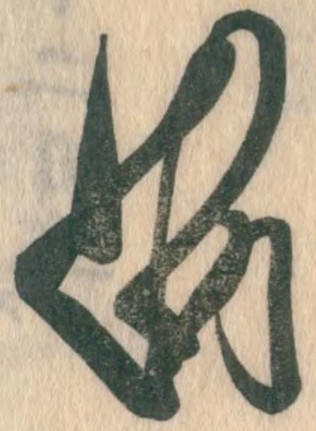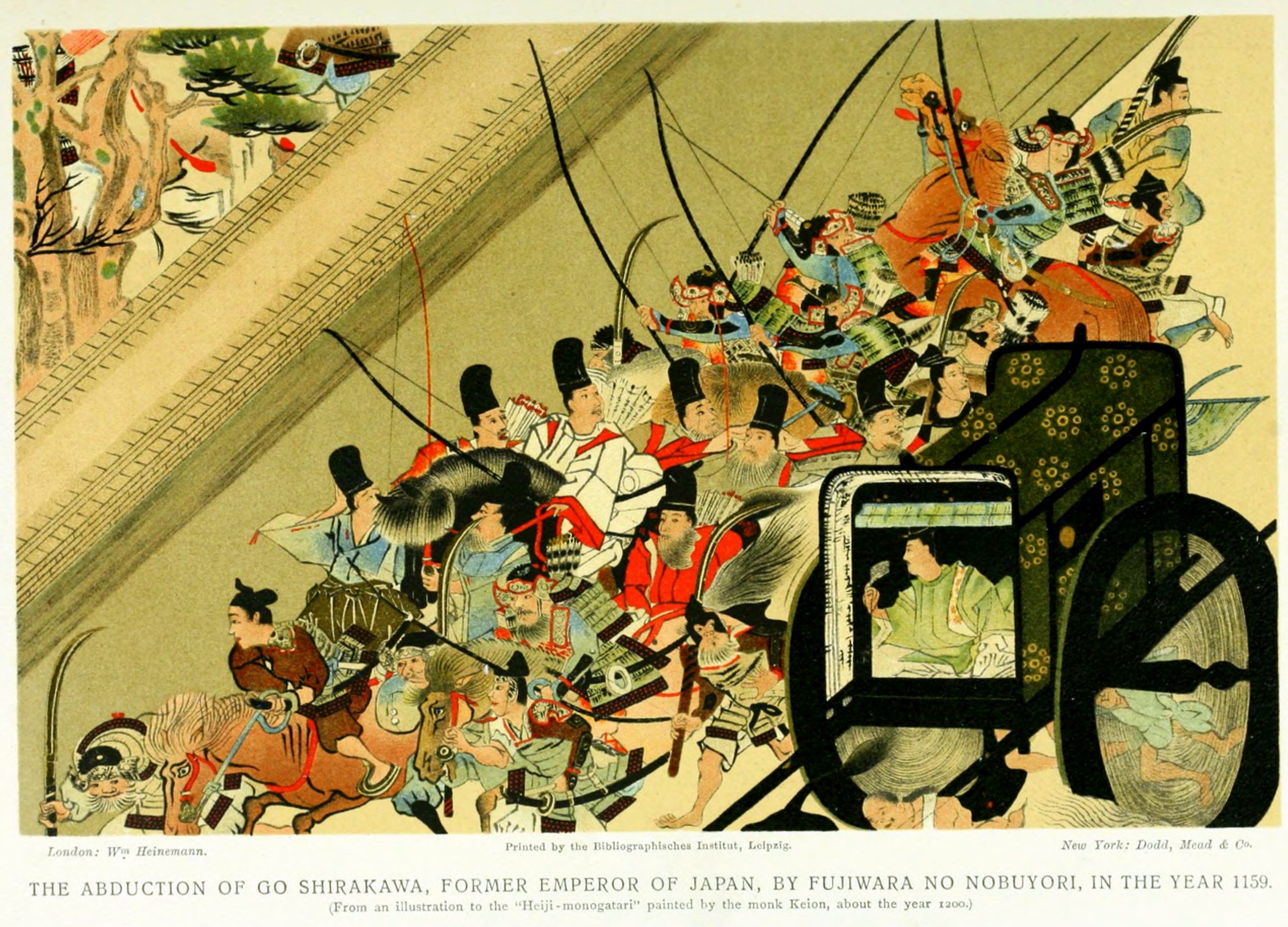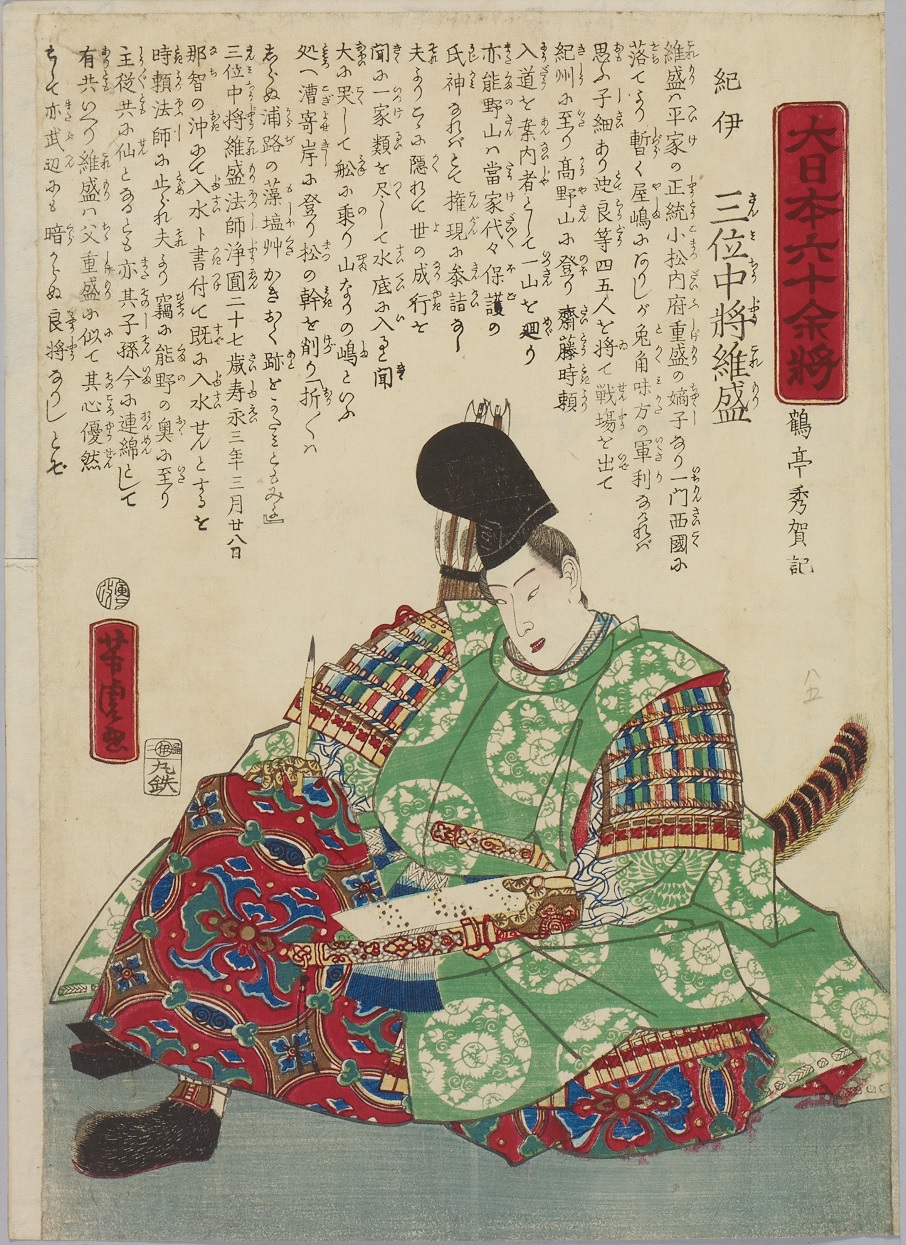|
Minamoto Yoshinaka
, , or Lord Kiso was a general from the late Heian period of Japanese history. A member of the Minamoto clan, Minamoto no Yoritomo was his cousin and rival during the Genpei War between the Minamoto and the Taira clans. Yoshinaka was born in Musashi province. His dharma name was Tokuon'in Gisan Senkō (徳音院義山宣公). Early life Yoshinaka's father, Minamoto no Yoshikata, was killed by Minamoto no Yoshihira in 1155. Yoshihira also sought to kill Yoshinaka who escaped to Shinano Province. He was raised by Nakahara Kaneto, Imai Kanehira's father, together with his milk-brother Imai Kanehira, who would later become his best friend and most loyal retainer. Yoshinaka later changed his name from Minamoto to , to reflect the Kiso Mountains where he was raised. Genpei War Yoshinaka accepted Prince Mochihito's call to the Minamoto clan to rise against the Taira in 1181. He entered the Genpei War by raising an army and invading Echigo Province. He then defeated a Tai ... [...More Info...] [...Related Items...] OR: [Wikipedia] [Google] [Baidu] |
Heian Period
The is the last division of classical Japanese history, running from 794 to 1185. It followed the Nara period, beginning when the 50th emperor, Emperor Kanmu, moved the capital of Japan to Heian-kyō (modern Kyoto). means "peace" in Japanese. It is a period in Japanese history when the Chinese influences were in decline and the national culture matured. The Heian period is also considered the peak of the Japanese imperial court and noted for its art, especially poetry and literature. Two types of Japanese script emerged, including katakana, a phonetic script which was abbreviated into hiragana, a cursive alphabet with a unique writing method distinctive to Japan. This gave rise to Japan's famous vernacular literature, with many of its texts written by court women who were not as educated in Chinese compared to their male counterparts. Although the Imperial House of Japan had power on the surface, the real power was in the hands of the Fujiwara clan, a powerful aristocratic f ... [...More Info...] [...Related Items...] OR: [Wikipedia] [Google] [Baidu] |
Siege Of Hiuchi
was one of Minamoto no Yoshinaka's fortresses in Echizen Province, Japan. In April and May 1183, a Taira force led by Taira no Koremori attacked the fortress. It was built on rocky crags, and well-defended; the Minamoto had even built a dam to create a moat. However, a traitor within the fortress tied a message to an arrow, firing it into the Taira camp, and revealing a way to breach the dam and drain the water. The castle soon fell to the Taira The Taira was one of the four most important clans that dominated Japanese politics during the Heian, Kamakura and Muromachi Periods of Japanese history – the others being the Fujiwara, the Tachibana, and the Minamoto. The clan is divided i ..., but Yoshinaka and much of his forces survived and escaped. References {{coord missing, Japan 1180s in Japan 1183 in Asia Hiuchi 1183 Hiuchi 1183 Conflicts in 1183 ... [...More Info...] [...Related Items...] OR: [Wikipedia] [Google] [Baidu] |
Ōmi Province
was a province of Japan, which today comprises Shiga Prefecture. It was one of the provinces that made up the Tōsandō circuit. Its nickname is . Under the ''Engishiki'' classification system, Ōmi was ranked as one of the 13 "great countries" (大国) in terms of importance, and one of the "near countries" (近国) in terms of distance from the capital. Ōmi bordered on Wakasa and Echizen Provinces to the north, Mino and Ise Provinces to the east, Iga and Yamato Provinces to the south, and Yamashiro and Tanba Provinces to the east. Lake Biwa, Japan's largest lake, is located at the center of the province. History The area of Ōmi has been settled since at least the Yayoi period, and the traces of several large settlements have been found. During the Kofun period, the area appears to have been dominated by several powerful immigrant clans, most notably the Wani clan, originally from Baekje. The names of "Ōmi" or "Lake Biwa" do not appear in the ''Kojiki'', '' Man'yōs ... [...More Info...] [...Related Items...] OR: [Wikipedia] [Google] [Baidu] |
Battle Of Awazu
Minamoto no Yoshinaka made his final stand at Awazu, after fleeing from his cousins' armies, which confronted him after he attacked Kyoto, burning the Hōjūjiden, and kidnapping Emperor Go-Shirakawa. During the pursuit he was joined by his foster brother Imai Kanehira and Tomoe Gozen. During the battle, they fought valiantly, holding off Noriyori's large force of thousands of men for a time. However, in the end, they both died in battle. Yoshinaka was struck dead by an arrow when his horse became mired in a paddy field. Kanehira committed suicide by leaping off his horse while holding his sword in his mouth. Gallery File:Toyoharu Awazu.jpg, Woodblock print of the battle of Awazu, by Utagawa Toyoharu, ca. 1760s. Yoshinaka and Kanehira's deaths are depicted in the left middle distance. File:Battle of Awazugahara.jpg, Tomoe Gozen Tomoe Gozen (, ) was an onna-musha from the late Heian period of Japanese history. She served Minamoto no Yoshinaka during the Genpei War and ... [...More Info...] [...Related Items...] OR: [Wikipedia] [Google] [Baidu] |
Minamoto No Noriyori
was a late Heian period general, who fought alongside his brothers Minamoto no Yoritomo and Minamoto no Yoshitsune at a number of battles of the Genpei War. He was the sixth son of Minamoto no Yoshitomo. Early life As children, he and his brothers Yoritomo and Yoshitsune were spared by Taira no Kiyomori in 1160, following the death of their father, Minamoto no Yoshitomo, after their mother Tokiwa became Kiyomori's concubine. Genpei War Noriyori seemingly disappears from any record until 1180, when he served his brother Yoritomo in Kamakura. Beginning in 1184, four years into the Genpei War, he was sent out from Kamakura by Yoritomo, and made his way to the Taira strongholds of Shikoku. Noriyori helped defeat the wayward Minamoto no Yoshinaka, his cousin, at the Second Battle of the Uji and the Battle of Awazu, before moving on to play a central role in the Battle of Ichi-no-Tani. The Taira were pushed back, and the war fell into a lull for about six months, during which Nori ... [...More Info...] [...Related Items...] OR: [Wikipedia] [Google] [Baidu] |
Minamoto No Yoshitsune
was a military commander of the Minamoto clan of Japan in the late Heian and early Kamakura periods. During the Genpei War, he led a series of battles which toppled the Ise-Heishi branch of the Taira clan, helping his half-brother Yoritomo consolidate power. He is considered one of the greatest and the most popular warriors of his era, and one of the most famous samurai in the history of Japan. Yoshitsune perished after being betrayed by the son of a trusted ally. Early life Yoshitsune was the ninth son of Minamoto no Yoshitomo, and the third and final son and child that Yoshitomo would father with Tokiwa Gozen. Yoshitsune's older half-brother Minamoto no Yoritomo (the third son of Yoshitomo) would go on to establish the Kamakura shogunate. Yoshitsune's name in childhood was Ushiwakamaru or ''young bull'' (). He was born just before the Heiji Rebellion in 1160 in which his father and two oldest brothers were killed. He survived this incident by fleeing the capital with his ... [...More Info...] [...Related Items...] OR: [Wikipedia] [Google] [Baidu] |
Shōgun
, officially , was the title of the military dictators of Japan during most of the period spanning from 1185 to 1868. Nominally appointed by the Emperor, shoguns were usually the de facto rulers of the country, though during part of the Kamakura period, shoguns were themselves figureheads, with real power in hands of the Shikken of the Hōjō clan. The office of shogun was in practice hereditary, though over the course of the history of Japan several different clans held the position. The title was originally held by military commanders during Heian period in the eighth and ninth centuries. When Minamoto no Yoritomo gained political ascendency over Japan in 1185, the title was revived to regularize his position, making him the first shogun in the usually understood sense. The shogun's officials were collectively referred to as the ; they were the ones who carried out the actual duties of administration, while the Imperial court retained only nominal authority.Beasley, William G ... [...More Info...] [...Related Items...] OR: [Wikipedia] [Google] [Baidu] |
Minamoto No Yukiie
was the brother of Minamoto no Yoshitomo, and one of the commanders of the Minamoto forces in the Genpei War at the end of the Heian period of Japanese history. In 1181, he was defeated at the Battle of Sunomatagawa by Taira no Shigehira. After the humiliation, he fled again to Yahagigawa bridge, where he tried destroying it. However, the Taira caught up and fought back, destroying his forces in the Battle of Yahagigawa. However, the pursuit was called off when the Taira leader, Tomomori, got sick. Yukiie was then able to join Minamoto no Yoshinaka in besieging the capital city in the summer of 1183. Taira no Munemori was forced to flee with the young emperor while the cloistered emperor joined Yoshinaka. For a time, Yukiie plotted with Minamoto no Yoshinaka against Yoritomo, the head of the clan. But when Yoshinaka suggested kidnapping the cloistered Emperor Go-Shirakawa, Yukiie betrayed him, revealing his plan to Emperor Go-Shirakawa, who in turn revealed it to Yoritomo. ... [...More Info...] [...Related Items...] OR: [Wikipedia] [Google] [Baidu] |
Emperor Go-Shirakawa
was the 77th emperor of Japan, according to the traditional order of succession. His de jure reign spanned the years from 1155 through 1158, though arguably he effectively maintained imperial power for almost thirty-seven years through the ''insei'' system – scholars differ as to whether his rule can be truly considered part of the ''insei'' system, given that the Hōgen Rebellion undermined the imperial position. However, it is broadly acknowledged that by politically outmaneuvering his opponents, he attained greater influence and power than the diminished authority of the emperor's position during this period would otherwise allow. Posthumously, this 12th-century sovereign was named after the 11th-century Emperor Shirakawa. ''Go-'' (後), translates literally as "later"; and thus, he is sometimes called the "Later Emperor Shirakawa", or in some older sources, may be identified as "Shirakawa, the second" or as "Shirakawa II". Unusually, the years of Go-Shirakawa's reign are ... [...More Info...] [...Related Items...] OR: [Wikipedia] [Google] [Baidu] |
Emperor Antoku
was the 81st emperor of Japan, according to the traditional order of succession. His reign spanned the years from 1180 through 1185. During this time, the Imperial family was involved in a bitter struggle between warring clans. Minamoto no Yoritomo with his cousin Minamoto no Yoshinaka, led a force from the Minamoto clan against the Taira, who controlled the emperor. During the climactic sea Battle of Dan-no-ura in April 1185, Antoku's grandmother Taira no Tokiko took him and plunged with him into the water in the Shimonoseki Straits, drowning the child emperor rather than allowing him to be captured by the opposing forces. The conflict between the clans led to numerous legends and tales. The story of Emperor Antoku and his mother's family became the subject of the Kamakura period epic poem ''The Tale of the Heike'' (Heike is an alternative reading of the Japanese characters for "House of the Taira"). Antoku's tomb is said to be located in a number of places around western Japa ... [...More Info...] [...Related Items...] OR: [Wikipedia] [Google] [Baidu] |
Battle Of Kurikara
The , also known as the battle of Tonamiyama (砺波山), was a crucial engagement in Japan's Genpei War The was a national civil war between the Taira and Minamoto clans during the late Heian period of Japan. It resulted in the downfall of the Taira and the establishment of the Kamakura shogunate under Minamoto no Yoritomo, who appointed himself ...; in this battle the tide of the war turned in the favour of the Minamoto clan. "Yoshinaka won by a clever strategy; under cover of nightfall his troops enveloped the main body of the Taira, demoralized them by a series of tactical surprises, and turned their confusion into a disastrous, headlong rout." Background Minamoto no Yoshinaka, commander of a contingent of warriors from Shinano Province, invaded Taira lands in Shinano, Echigo Province, Echigo, Etchū Province, Etchū, Kaga Province, Kaga and Echizen Province, Echizen. The war was put on hold in 1181 on account of two years of famine. As conditions improved in 1183, th ... [...More Info...] [...Related Items...] OR: [Wikipedia] [Google] [Baidu] |
Taira No Koremori
(1158 – 1184) was one of the Taira clan's commanders during the Genpei War of the late Heian period of Japanese history. He was the eldest son of Taira no Shigemori, who was the eldest regent and heir of Taira no Kiyomori. Early life Taira no Koremori was born in 1158. In contrast to his father, who was a warrior focused on battle, he grew up to be a young nobleman who enjoyed poetry and music. Genpei War During the Genpei War, Koremori lost the Battle of Fujikawa in 1180. He invaded three years later Echizen Province, taking Hiuchiyama and several other of Minamoto no Yoshinaka's strongholds. However, Yoshinaka was able to take back the strongholds and defeat Koremori during the Battle of Kurikara. Koremori fled the Heike headquarters during the Battle of Yashima, and sought to reunite with his family left behind in the capital. However, along the way back he met the priest Takiguchi, formerly Saito Tokiyori, on Mount Kōya and became a monk. The rumor later spread t ... [...More Info...] [...Related Items...] OR: [Wikipedia] [Google] [Baidu] |






